SYMBOLISM OF THE SNAKE
by W.B. Harold Meij
Introduction
I have often been asked by the Brethren on where I was passed and
raised. Actually, I was initiated in Sinim, passed in The Netherlands, and
raised in the USA. To this, I am often asked what some of the differences
are in the symbols and rituals Freemasons use in Europe. Obviously we
could spend many hours discussing these differences, but I would like to
concentrate tonight on one particular symbol - "The Snake".
Before I begin however, I would like to point out that the purpose of
the presentation is not to present the one and only explanation of symbols
or rituals. It is only meant to shed a different light on the subject, and
as an open-minded opinions, and freedom of interpretation, form the basis
of Freemasonry, I am only presenting one possible interpretation. The
Brethren should ultimately make their own judgment and interpretation.
Before a lodge is opened in Europe, the WM asks the Brethren to dress
Masonically. We then proceed to dress ourselves in silence, obviously, as
dressing Masonically is almost a sacred act, an act throughout which we
are supposed to remember and remind ourselves of the symbolic meaning of
the jewel, apron, and the meaning of the white gloves. Yet doing so every
other week, has made it practically second nature to us. We automatically
tie a knot in our apron, or hook together the two ends. We automatically
don our jewels and take our places within the lodge. But let us look a
little closer at our apron and its components.
In the old days, the aprons were tied from the center, and around the
waist. The ancient Egyptian priests tied their knots in such a way that
there formed a loop on the left hip. The two remaining pieces were left
dangling. Through this, the famous Ankh, better known as the "Sign of
Life" was formed, which was also a symbol of the key which opened the door
between the material and the non-material. This symbol is at times used
above the outer door of the middle chamber in the second degree. In
another way of tying the knot, the two loose ends would fall in front of
the apron, hence our modern aprons show two dangling pieces.

An example of an Egyptian Ankh, or “sign of life”
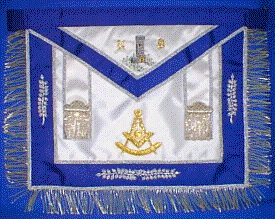
In our new aprons, we find two silver lined bands with seven balls
being suspended next to the triangle, which is similar to the old English
aprons. The two bands are probably reminisces of the two remaining rope
pieces by which the apron was tied together, and the silver lining is said
to symbolize the light which emanates from the apron. The seven balls are
said to represent the seven colors of the rainbow, or the seven planets,
some say the seven wonders of the world.
The “old” aprons
and “The Snake”
However, I would like to focus on the hook attached to our "old"
aprons, which are formed and decorated as a snake! Why is it formed like a
snake, what does the snake symbolize?
Let us first look at the band of the apron, which in itself is an
important symbol. The band separates the lower half of the body from the
upper half. Wearing a band around the waist is also said to be a sign of
stature, knowledge, or a particular promise. Remember for example the
cords monks wear, or the bands worn by knights, and modern army officers.
Even today, bands with color are expression of authority, such as the
Karate and Judo belts. To lay down ones band, or belt, means surrender or
to renounce ones duties, as army officers would do. Indeed, traditionally,
Islam spoke of the Christians who gave up their faith to become Muslims as
“snapping his girdle.”
But let me go back to our aprons, and the snake.
Symbolic meaning
of the snake
I believe that when we first think of the symbolic meaning of a snake,
that it reminds us of The Bible, and the Book of Genesis, and the story of
Adam and Eve. In Christian beliefs, the snake represents temptation and
evil, the snake is the servant of Satan.
It is interesting to note that the snake has an important role in many
culture's legends and fairy tales, but also in religious matters in the
West, as well as in the East. Not only is the creature itself described in
detail in these stories and ceremonies, but so are its characteristics,
such as the coiled body, the association with trees as in the Genesis
story, the regular shedding of its skin, its menacing hiss and split tong,
and the speed whereby it attacks from small crevasses, or from an open
field. Due to these dynamic characteristics, the snake plays an important
role in religious matters around the globe.
The snake and the Egyptians
I would like to give some examples of this. Maybe the history of Egypt
is the best known. The ancient Egyptian mythology states that the world
was created by four powers, or Gods. One was the sun God of Amun-Ra which
took the form of a snake and emerged from the water to inseminated the
cosmic egg which was created by the other gods. It was said that all life
on this earth stemmed from this egg.
We of course know also of the many struggles between Seth and Osiris,
the lord and judge of the dead. The father of Horus Seth and the brother
of Osiris tried to kill Osiris and take the world for themselves. So the
story goes, that on one attempt to take Osiri's life, a God named Hathor
transformed itself into a poisonous snake called Agep and killed the
would-be assassins. That snake also guarded the wheat fields where the
spirit of Horus was said to live. This brought the sheaf of wheat to be
regarded as the symbol of reliving, or rebirth. This symbol is also used
in our second degree.
In another we learn that a God, Isis, was transformed into a fire
spewing cobra (called Uraeus in Greek), and symbolized the bearer of this
symbol that he was in possession of the secrets of the material world. The
Pharaohs therefore wore the symbol of Uraeus on their head as a symbol of
sovereignty, or royalty. This snake worn on the head also indicated the
possession of the so-called third-eye, from which nothing could be hidden,
in this or in the next world.
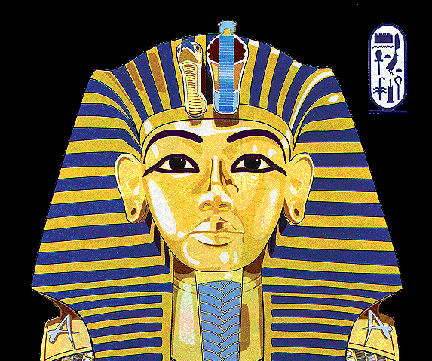
Example of the usage of the symbol of Uraeus
Other examples of the snake
The same interpretation is made by the practitioners of Yoga, who claim that
ones inner strength is like a coiled-up snake which is deep within oneself. By
practicing Yoga, this snake will extend itself through the several so-called
Chakras, and eventually reach the head and form the third eye.
The Hindu also principally follow this thinking, that at that moment when the
snake, or spirit, awakes through strict religious practices and rises into
eternity, one can reach the ultimate state of humanity.
In Greek mythology also, the snake plays an important role. It is said that
the Zeus freed eagles at each end of the world. The place where these two eagles
met was the center of the world, the center of the earth. This center, sometimes
called the navel of the earth, is guarded by a snake, called Pytho. Above this
navel the Oracle of Delphi, called Pythia, was constructed. We see this Oracle
play an important role in the life of Pythagoras.
The snake is also used by Chinese mythology. The Chinese maintained that the
world was surrounded by two intertwined snakes, which symbolized the power and
wisdom of the creator. (Ying/Yang) However, the snake was also said to cause the
devastating floods, as the movement of the water resembled a snakes
movement.
The Aztecs too placed high regard for the snake, which they called by the
almost unpronounceable name of Quetzacoatl. This snake was feathered so that it
could communicate with the Gods. The use of this snake is widespread, the most
famous of stories entails an Aztec King who seeks immortality, and to find it
sets out to sea on a raft laden with snakes. The soothsayers claimed that one
day, a new god would return from the seas. That he will have long blond hair,
blue eyes, and will be wearing a brighten armor. This vision was very much taken
advantage of in 1519 when the Spanish conqueror Ferdinando Cartez invaded
Mexico.
The Australian Aborigines see the snake as the beast that will make them man
by devouring them as boys, and re-emerging as man. Do we not see similarities
between his and the story where the Jonas traveled the seas, to be devoured by a
whale, and spewed out three days later a new man? It is also similar to Baptism,
which took place in the river Jordan on Easter, where people would be submerged
in the water, where it was said that a beast of the underworld devoured their
soul, after which one would re-emerge a new man. In these stories, the
characters are often given a new name after such a rebirth, after being added to
a new group of people. Do we not see this phenomenon in our own degrees, where
through initiation, passing and raising a new name is given?
The snake as a duality
We can conclude from these examples, that the snake has both positive and
negative images. In positive stories it creates the world, in others, it causes
flooding, devastation, even death. The snake therefore is usually portrayed as a
duality.
In “The Book of the Dead”, we learn that snakes were the first to acclaim Ra
when he appears from the surface of the waters, and hence, snakes were referred
to as the lowest strata of life. Therefore man, who is considered to be at the
very top of the strata of life, wearing a snake as in our aprons, continually
reminds us of where we came from, and of what we are in search.
In The Book of Numbers, for example, we find the story whereby the serpents
sent by God cause many of the children of Israel to perish, but His chosen
people were restored to life by the same serpents (Numbers 21:6-9).
We learn in another example that in Paradise there are two trees, the tree of
life and the tree of knowledge. Symbolically the tree of life holds the world
together in harmony and represents truth. The other tree gives the temptation of
body, of earthly things, and discord. Again, a duality between harmony and
disharmony, good and bad, truth and lies is present. We know what happens with
the snake and the apple. But how can the snake, a symbol of evil, be used to
tempt Eve? For in the Bible, God declares after creating the heaven and the
earth in 6 days, that "I am the creator of good and evil."
If we follow this logic, then the snake should not be seen as a tool of evil,
but a tool of good, which was created by God and which taught men the notion of
choices by eating an apple from the tree of knowledge, of the duality of this
world of two opposites, life and death, happiness and sadness. It is through the
work of the snake, that man is the only being on earth with the power to choose
between this duality, to be given a choice, and have a free will to choose. The
snake therefore symbolizes something very important. It is a symbol to which we
must work to rise above the material to a wider and higher knowledge of the
world. The snake helps us bring out our inner strength.
Many philosophers refer to the snake in the same way. In the famous story by
the German philosopher Goethe called "The Green Snake" we learn of a king who
enters a mysterious temple where he through comparisons and choices is taught
how to gap the bridge between the human mistakes and the ideal state. The snake
plays an important role in this story.
This story is reflected in Italian Freemasonry, where the Brethren often wear
a green band on their arms, symbolizing this quest. History also shows that the
Italian Fascists, who regard Masonry as an enemy to their ways, referred to
masons as "Serpente Verte", or green snakes.
The snake as the Ouroboros
The re-living or re-experience which the snake represents is also well
represented in the symbol Serpens Candivorens, a snake which bites itself in its
tail, representing the unending cycle of nature between destruction, and new
creation, life and death. The Greeks called this figure Ouroboros, which was
expressed as the Ying-Yang symbol in the Orient. A dual snake has also been used
as a symbol of medicine, probably also reflecting this interpretation, as we can
see from my paramedic uniform.
The snake we have seen plays an important role in symbolism, and I hope to
have explained a little more why the snake is chosen as our hook on our aprons.
In the higher degrees of masonry, we find the snake extensively used. The 25th
degree for example is the degree of The Knight of The Brazen Serpent, in which
the symbols I have covered can be seen, including an Orobouros. The degree
symbolizes the wandering of the children of Israel through the wilderness, and
who rail against Moses. Serpents are send from God to punish those who were
ungrateful, and many die. Moses then erects a pole with a brazen serpent on it,
and as we see from Number 21:9 "Any who are bitten may look upon it and not
die".
So finally, why the snake on our aprons?
I reiterate that the interpretation of symbols is something personal, and we
should all make our own judgment. Maybe however, we can see the snake on our
aprons as the guardian of the secrets of one's inner strength. Maybe our entire
apron band represents a snake, an Ouroboros, to remind us to seek deeper
insights, or maybe to seek inner strength as outlined in another legend which
has it that Buddha was attacked by a snake which bound itself 7 times around the
Buddha's waist, but that through the inner strength of the Buddha the snake
could not kill him, and instead became his follower. The snake thus helped
Buddha realize his inner strength, and in a way helped him attain a higher
plain.
Conclusions
From the above, we can see that we have lost a very precious and deep symbol
from our aprons by having changed it to a simple hook and band we use when we
wear our current aprons. Knowing however some reasons why our old aprons did
have a snake will help us focus us on the importance of our labors which await
us.
Examples of Ouroboros
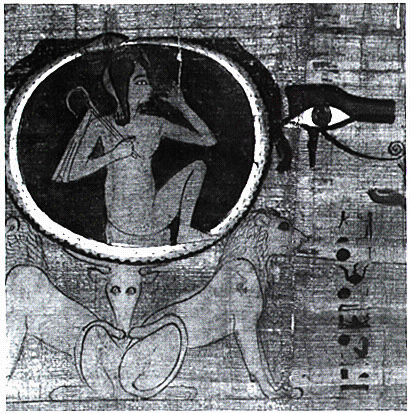
Papyrus
of Dama Heroub, Egypt, 21st Dynasty.
The zodiac as a tail-eating snake (Ouroboros) symbolizes the eternity of Time
and the boundary of the universe. Below it, the double lion Routi ('Yesterday
and Tomorrow'),
the agency of resurrection, supporting the newborn Sun
God.

From
ancient Graeco-Byzantine alchemal text relating to the manufacture of
gold.
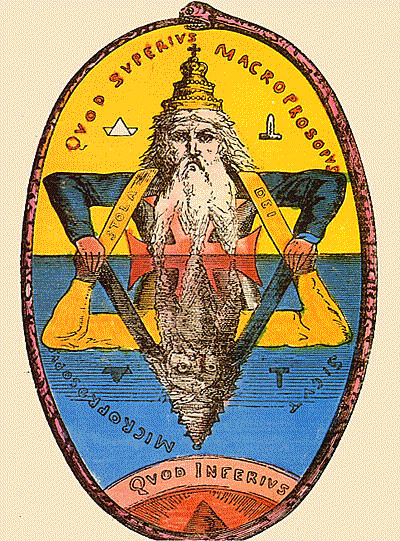
"The
Double Triangle of Solomon", represented by the two ancients of the Cabbala
the Macroprosopus and the Microprosopus, the god of light and the God of
Reflections,
from Eliphas Levi's Transcendental Magic, 1896
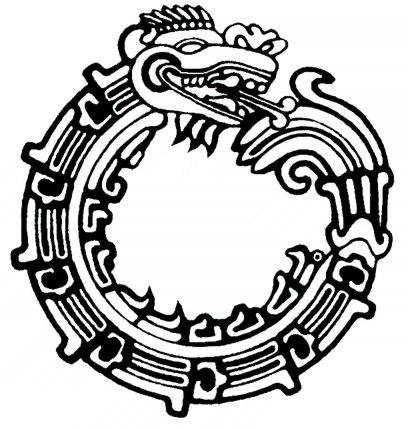
The Aztec
representation of Quetzacoatl
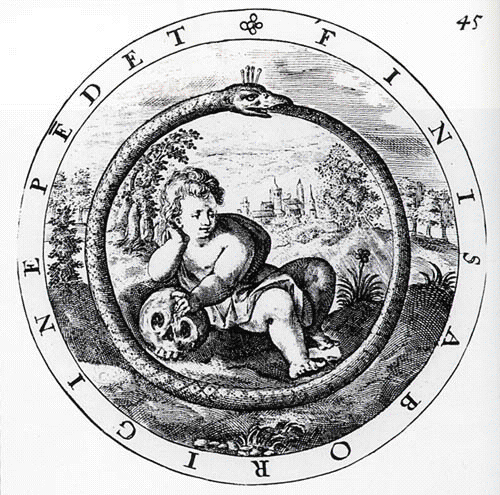
Ouroboros
as emblem of mortality,
from George Wither's A Collection of Emblems, Ancient
and Modern, 1635
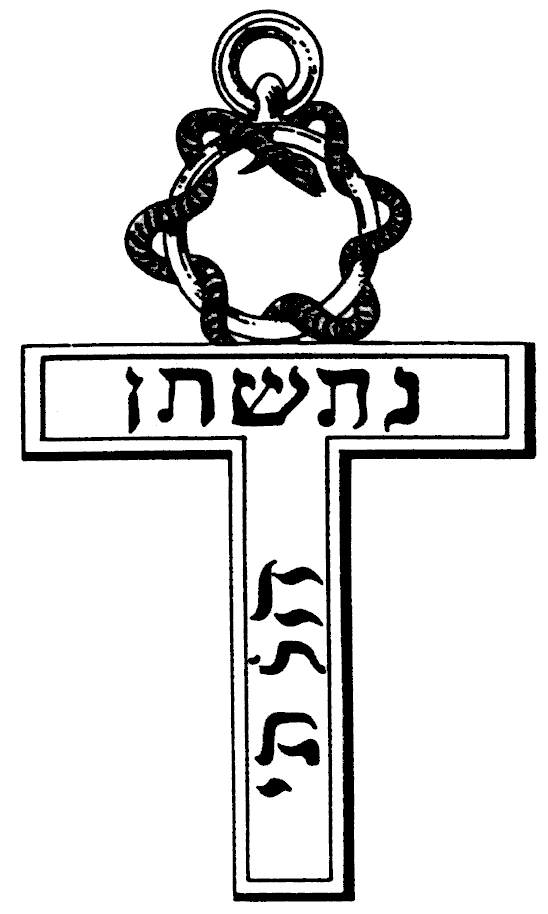
The Jewel of the 25th degree in the Scottish
Rite
back to top |
![]()














